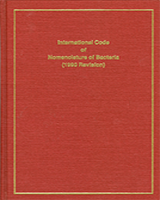General Considerations (original) (raw)
NCBI Bookshelf. A service of the National Library of Medicine, National Institutes of Health.
Lapage SP, Sneath PHA, Lessel EF, et al., editors. International Code of Nomenclature of Bacteria: Bacteriological Code, 1990 Revision. Washington (DC): ASM Press; 1992.
International Code of Nomenclature of Bacteria: Bacteriological Code, 1990 Revision.
Chapter 1General Considerations
General Consideration 1
The progress of bacteriology can be furthered by a precise system of nomenclature accepted by the majority of bacteriologists of all nations.
General Consideration 2
To achieve order in nomenclature, it is essential that scientific names be regulated by internationally accepted Rules.
General Consideration 3
The Rules which govern the scientific nomenclature used in the biological sciences are embodied in International Codes of Nomenclature (see Appendix 1 for a list of these Codes).
General Consideration 4
Rules of nomenclature do not govern the delimitation of taxa nor determine their relations. The Rules are primarily for assessing the correctness of the names applied to defined taxa; they also prescribe the procedures for creating and proposing new names.
General Consideration 5
This Code of Nomenclature of Bacteria applies to all bacteria. The nomenclature of certain other microbial groups is provided for by other Codes: fungi and algae by the Botanical Code, protozoa by the Zoological Code, and viruses by the Virological Code when it is approved (see Appendix 1).
General Consideration 6
This Code is divided into Principles, Rules, and Recommendations.
- The Principles (Chapter 2) form the basis of the Code, and the Rules and Recommendations are derived from them.
- The Rules (Chapter 3) are designed to make effective the Principles, to put the nomenclature of the past in order, and to provide for the nomenclature of the future.
- The Recommendations (Chapter 3) deal with subsidiary points and are appended to the Rules which they supplement. Recommendations do not have the force of Rules; they are intended to be guides to desirable practice in the future. Names contrary to a Recommendation cannot be rejected for this reason.
- Provisions for emendations of Rules, for special exceptions to Rules, and for interpretation of the Rules in doubtful cases have been made by the establishment of the International Committee on Systematic Bacteriology (ICSB) and its Judicial Commission, which acts on behalf of the ICSB (see Rule 1b and Statutes of the International Committee on Systematic Bacteriology, pp. 137–158 of this volume). Opinions issued by the Judicial Commission become effective after receipt of ten or more favorable votes from Commissioners, but may be rescinded by the ICSB as provided in ICSB Statute 8c (2). The official journal of the ICSB is the International Journal of Systematic Bacteriology (IJSB), formerly the International Bulletin of Bacteriological Nomenclature and Taxonomy (IBBNT). (Some other journal could be specified by the ICSB if required. Such possible future specification is implicit in the use of "International Journal of Systematic Bacteriology" or "IJSB" throughout this Code, but is not always repeated at each mention.)
- Appendices are added to assist in the application of this Code (see Contents).
- Reference is given in the Index to clauses in which Definitions of certain words used in the Code are provided. Such words are indicated in boldface type in the clause concerned and in the index, and they may be printed in boldface type elsewhere in this Code.
General Consideration 7
Nomenclature deals with the following:
- Terms used to denote the taxonomic categories, e.g., "species," "genus," and "family."
- Relative rank of the categories (see Rule 5).
- Names applied to individual taxa. A taxonomic group is referred to throughout this Code as a taxon, plural taxa. "Taxonomic group" is used in this Code to refer to any group of organisms treated as a named group in a formal taxonomy; it may or may not correspond to a category.
Examples: Name of a species, Pseudomonas (generic name) aeruginosa (specific epithet); name of a genus, Pseudomonas; name of a family, Pseudomonadaceae; name of an order, Pseudomonadales.
Editorial Note. Many examples are taken from names that lost their standing in nomenclature on publication of the Approved Lists of Bacterial Names; these examples have been retained because they illustrate nomenclatural problems which have occurred in the past and may occur again, but which cannot always be illustrated by names that are currently legitimate.
Copyright © 1992, International Union of Microbiological Societies.
Bookshelf ID: NBK8822
